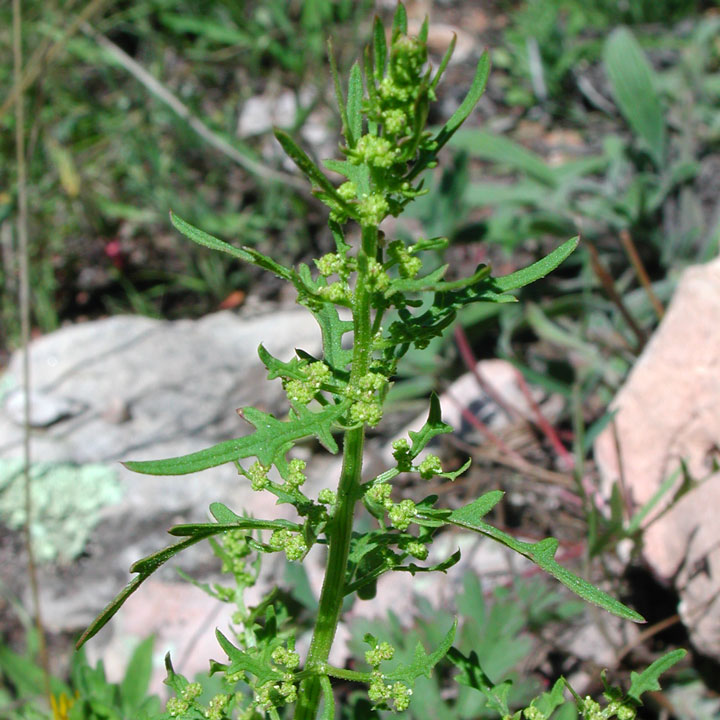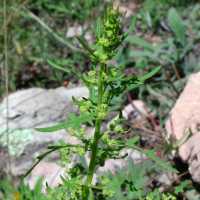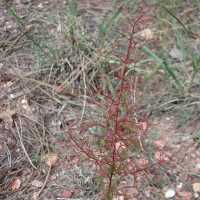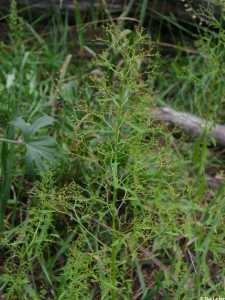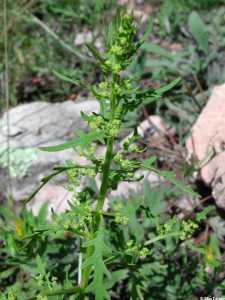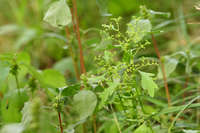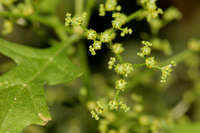Stems erect, 2.3-5.2 dm, sparsely pubescent with short hairs, these rarely with gland heads. Leaves aromatic; petiole to 1.3 mm; blade 1.7-4.5 × 0.7-2.6 cm, base cuneate, margins pinnatifid or entire (in distal leaves), apex acute to acuminate, mucronate, with sessile glands adaxially. Inflorescences terminal compound cymes, 8.5-22 cm; bracts leaflike, lanceolate, 2.1-10.3 × 0.1-0.6 mm, generally absent in fruit. Flowers: perianth segments 5, distinct nearly to base, distinct portion ovate, with large single tubercle abaxially near apex, 0.5-0.7 × 0.35-0.6 mm, apex acuminate, with sessile golden glands, covering seed at maturity; stamens 1(-2); stigmas 2. Achenes subglobose; pericarp adherent, membranaceous, papillose, becoming rugose, usually white-blotchy. Seeds subglobose, 0.6-0.9 × 0.5-0.7 mm, margins rimmed; seed coat rugose.
Fruiting late summer-fall. In shade of pines and junipers or occasionally in open dry plains, ridge tops, or in waste areas in the east; 900-2800 m; Ariz., Colo., La., Maine, Mass., N.Mex., N.Y., Tex., Utah; Mexico; Central America (Guatemala).
Western populations of Dysphania graveolens are native while those populations in the eastern part of the continent are considered introduced.
Duration: Annual
Nativity: Native
Lifeform: Forb/Herb
General: Strongly aromatic annual herb, 10-60 cm tall; stems erect, simple or branched from base, bright green with linear grooves, sparsely pubescent with short hairs. Plant turns bright red in autumn.
Leaves: Alternate and short-petiolate, the petioles to 1.3 mm; blades bright green, entire to pinnatifid, often widely morphologically variable on the same plant, aromatic with yellow glands on the lower leaf surface.
Flowers: Inconspicuous, green, and clustered in branch axils and on stem tips; perianth segments 5, with sessile golden glands, incompletely enclosing the fruit.
Fruits: Achenes rounded, whitish, with the pericarp adherent. Seeds 0.5 mm, dark brown, with a wrinkled seed coat.
Ecology: Found in disturbed areas, dry plains, ridgetops, and in pine forests and juniper woodlands, from 3,000-9,500 ft (914-2896 m); fruiting late summer-fall.
Distribution: Native to western N. Amer. from UT to w TX, south through AZ, NM, and MEX to S. Amer; introduced to ME, MA, NY, LA.
Notes: The genus Dysphania has often been included with the genus Chenopodium. Both genera are annual herbs with simple, alternate leaves, inconspicuous flowers in clusters, and single seeded fruits enclosed by the persistant calyx. Dysphania is set apart from Chenopodium by the strong scent of the herbage and the presence of glands rather than mealy hairs. D. graveolens is a bright green plant, turning red in the autumn, with pinnately-lobed leaves and yellow glands, especially on the calyx. It lives in the middle to higher elevations of the Southwest, especially on and above the Mogollon Rim and in the Sky Islands of Southern Arizona. During winter months, look for the reddish, thin skeletons of last year-s plants to sparkle in the sunlight, especially if remnant flowers are present. D. ambrosoides has a similar architecture and scent, but is gray-green, lacks the yellow glands on the calyx, and has a lower elevation, southern distribution in S. Ariz. and S. Cal. D. botrys is widespread but has a distinctively different architecture; the leaves are clustered on the lower stems near the base of the plant, from which point multiple long, narrow, nearly leafless panicles ascend. Look for it in Chenopodiaceae in older texts; that entire family is now considered to be part of Amaranthaceae.
Ethnobotany: Used as an emetic; for headaches; as protection in warfare and other ceremonial uses; and the seeds were eaten.
Etymology: Dysphania is from Greek dysphanis, for obscure, apparently alluding to the inconspicuous flowers; graveolens means strong-smelling.
Synonyms: Chenopodium graveolens, Chenopodium incisum, Teloxys graveolens
Editor: SBuckley 2011, LCrumbacher 2011, AHazelton 2015


